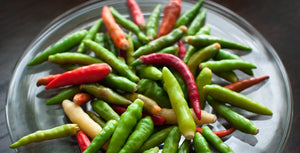Birdseye Chilli Pepper
This is THE chilli pepper of Southeast Asia. The Bird’s Eye Chilli is a key ingredient in many southeast asian dishes and is often referred to simply as the Red Thai Chilli Pepper due to its role in Thai cuisine.
Scoville scale (SHUs) |
50,000 to 100,000 SHUs |
Claim to Fame |
Extensively used in South-East Asia |
It is a long, shiny and predominantly red chilli that grows to about seven centimeters. While relatively thin, it still offers a slight fruity juice and a burn that will hit the tongue. Lucky for you, the pain won’t travel through the rest of your body, but stay on the tip of your tongue, lips and mouth.
You would have heard the warnings when dealing with Thai or Cambodian cuisine: beware of the heat. This is mostly thanks to the tiny Bird’s Eye chilli. When ordering a southeast asian dish you’ll often be asked how many chillies to add to the meal. Even adding just one chilli to the meal can still leave you with a burn. So take the warnings, and chew with caution.
This spicy jewel isn’t only used in Thailand but also widely used in Malaysian, Lao, Indonesian and Vietnamese food. Southeast asian cuisine is a clever mixture of curries, spices, salads, stir-fries, soups, rice and noodles. With India and China as the two influencers of the region, Southeast Asia food takes the best from both worlds.
Where does it really come from?
While it is used extensively in Southeast Asia cuisine, it was brought over by the europeans. Like most other chilli peppers, the Bird’s Eye originates from the Americas and didn’t hit the asian market until the end of the 16th century.
The name, on the other hand, doesn’t have much to do with its origins but rather its means of dispersal. Birds, who do not feel the burn of the chilli, will pick and drop the peppers in new places and so help the plant to spread.
Do you really need to take the heat warnings of Southeast Asian food?
To put it simply, yes. The Bird’s Eye chilli ranges from 50,000 to 100,000 Scoville Heat Units. As a regular addition in southeast cuisine you’ll always be feeling some level of spice. Consider commercial Mexican cuisine. This relies on Jalapeño chillies to give the meal heat, ranging only between 2,500 - 8000 Scoville Heat Units. In comparison to the Bird’s Eye this is a small dot on the spectrum. So the warnings should be taken with care.
However, Habaneros, often flavouring your spicy hot salsas, range from 100,000 - 350,000 on the Scoville scale. Here we’re entering the beginning of daredevil territory, where people know the risk they’re taking.
So for the average citizen, eager for a taste of Southeast Asian cuisine, go lightly on the Bird’s Eye Chilli until you build up a tolerance.
Where have you seen the Bird’s Eye chilli used before?
Nam pla prik. Even if you’re not familiar with thai cuisine, you’re sure to have seen this sauce in some petite southeast asian restaurant. Sitting on the edge of your table, it’s a small bowl of fish sauce with floating pieces of chilli. Every place will have its own variety, yet often this will be Bird’s Eye chilli.
In most southeast cuisine the Bird’s Eye Chilli is added to soups, salads, curries and stir-fries. The famous spicy hot papaya salad, uses the chilli, as well the renowned Pho (Vietnamese beef noodle soup). Mostly the pepper is sliced or cooked whole, but it can also be dried and grounded into a powder for a paste or seasoning over meats and fish.
To find out more about other chilli favourites
| 7 Pot Chilli | Read the blog | Explore the range |
| Aji Chilli | Read the blog | Explore the range |
| Bhut Jolokia (Ghost Chilli) | Read the blog | Explore the range |
| Birdseye | Read the blog | Explore the range |
| Carolina Reaper | Read the blog | Explore the range |
| Cayenne | Read the blog | Explore the range |
| Fatalii | Read the blog | coming soon |
| Habanero | Read the blog | Explore the range |
| Jalapeño | Read the blog | Explore the range |
| Naga Viper | Read the blog | Explore the range |
| Piri Piri | Read the blog | coming soon |
| Scotch Bonnet | Read the blog | Explore the range |
| Trinidad Scorpion | Read the blog | Explore the range |

